Direct Metatranscriptomic Survey of the Sunflower Microbiome and Virome
Abstract
:1. Introduction
2. Materials and Methods
2.1. Field Sampling and Sample Processing
2.2. RNA Extraction
2.3. Library Construction
2.4. Sequence Analysis
3. Results
3.1. Metatranscriptomic Comparison of Microbiome/Virome from Two Libraries
3.2. Endornavirus Genome
3.3. Putative Mitovirus Genome
3.4. Putative Partitivirus Genome
3.5. Putative Totivirus Genome
4. Discussion
Author Contributions
Funding
Institutional Review Board Statement
Informed Consent Statement
Data Availability Statement
Acknowledgments
Conflicts of Interest
Appendix A
| Contig Name | SF 1 Read Counts | SF 2 Read Counts | Abbreviation | Genbank Accession | Genome | Contig Length (nt) | Identity (%) | Putative Function (Most Similar Virus) |
|---|---|---|---|---|---|---|---|---|
| Helianthus annuus alphaendornavirus | 16,590 | 36 | HaEV1 | MT873524 | ss(+) RNA | 14645 | 99.8 | RdRp, Helianthus annuus alphaendornavirus |
| Helianthus annuus leaf-associated mitovirus 1 | 208,030 | 130 | HlaMV1 | MT860450 | ss(+) RNA | 2280 | 43.9 | RdRp, Ophiostoma_mitovirus_3a |
| Helianthus annuus leaf-associated mitovirus 2 | 136 | 8446 | HlaMV2 | MT860451 | ss(+) RNA | 2192 | 36.2 | RdRp, Cryphonectria_parasitica_mitovirus_1-NB631 |
| Helianthus annuus leaf-associated partitivirus 1 | 5528 | 6816 | HlaPV1 | MT873525 | dsRNA | 1775 | 66.8 | RdRp, Raphanus sativus cryptic virus 1 |
| Helianthus annuus leaf-associated partitivirus 2 | 11,560 | 13,174 | HlaPV2 | MT873526 | dsRNA | 1593 | 60.5 | RdRp, Medicago sativa deltapartitivirus 1 |
| Helianthus annuus leaf-associated partitivirus 3 | 10,340 | 8 | HlaPV3 | MT873527 | dsRNA | 1721 | 76 | RdRp, Verticillium dahlia Partitivirus 1 |
| Helianthus annuus leaf-associated totivirus 1 | 12 | 3867 | HlaTV1 | MT873528 | dsRNA | 4924 | 50 | RdRp, Puccinia striiformis totivirus 4 |
| Helianthus annuus leaf-associated totivirus 2 | 4 | 1502 | HlaTV2 | MT873529 | dsRNA | 3854 | 37 | RdRp, Puccinia striiformis totivirus 2 |
| Helianthus annuus leaf-associated totivirus 3 | 0 | 540 | HlaTV3 | MT873530 | dsRNA | 2489 | 49 | RdRp, Puccinia striiformis totivirus 5 |
| Helianthus annuus leaf-associated totivirus 4 | 2 | 580 | HlaTV4 | MT873531 | dsRNA | 2887 | 79 | RdRp, Puccinia striiformis totivirus 5 |
| H_annus_leaf-associated_partitivirus_4 | 23 | 8 | HlaPV4 | MZ532542 | dsRNA | 381 | 67.5 | CP; Echinochloa crusgalli partitivirus |
| H_annus_leaf-associated_cryptic_virus_1 | 14,353 | 16,428 | HlaCV1 | MZ532543 | dsRNA | 1447 | 41.1 | CP; Pyrus pyrifolia cryptic virus |
| H_annus_leaf-associated_partitivirus_5 | 7020 | 3 | HlaPV5 | MZ532544 | dsRNA | 1625 | 67.6 | CP; Verticillium dahliae partitivirus 1 |
| H_annus_leaf-associated_totivirus_5 | 16 | 3083 | HlaTV5 | MZ532545 | dsRNA | 3121 | 39.8 | CP; Cronartium ribicola totivirus 3 |
| H_annus_leaf-associated_totivirus_6 | 0 | 1065 | HlaTV6 | MZ532546 | dsRNA | 2907 | 75.6 | CP; Uromyces totivirus B |
| H_annus_leaf-associated_totivirus_7 | 23 | 1468 | HlaTV7 | MZ532547 | dsRNA | 1965 | 39.3 | CP; Totiviridae sp. |
| H_annus_leaf-associated_totivirus_8 | 18 | 1826 | HlaTV8 | MZ532548 | dsRNA | 2061 | 62.5 | CP; Puccinia striiformis totivirus 3 |
| H_annus_leaf-associated_totivirus_9 | 6 | 719 | HlaTV9 | MZ532549 | dsRNA | 2536 | 36.6 | CP; Puccinia striiformis totivirus 1 |
| H_annus_leaf-associated_totivirus_10 | 8 | 873 | HlaTV10 | MZ532550 | dsRNA | 2380 | 65.2 | CP; Puccinia striiformis totivirus 1 |
| H_annus_leaf-associated_totivirus_11 | 9 | 417 | HlaTV11 | MZ532551 | dsRNA | 2189 | 45.9 | CP; Cronartium ribicola totivirus 5 |
| H_annus_leaf-associated_victorivirus_1 | 0 | 203 | HlaVV1 | MZ532552 | dsRNA | 1263 | 41.3 | CP; Alternaria alternata victorivirus 1 |
| H_annus_leaf-associated_totivirus_12 | 4 | 671 | HlaTV12 | MZ532553 | dsRNA | 1709 | 40.6 | CP; Totiviridae sp. |
| H_annus_leaf-associated_totivirus_13 | 18 | 386 | HlaTV13 | MZ532554 | dsRNA | 1613 | 83.6 | CP; Uromyces totivirus D |
| Bean yellow mosaic virus | 13 | 14 | HlaPoV1 | MZ532555 | ssRNA | 555 | 99.5 | CP; Bean yellow mosaic virus |
| H_annus_leaf-associated_cryptic_virus_2 | 1217 | 812 | HlaCV2 | MZ532556 | dsRNA | 1585 | 46.1 | CP; Raphanus sativus cryptic virus 1 |
| Sclerotinia sclerotiorum hypovirulence-associated DNA virus 1-like virus | 2 | 4 | SsHADV-1 like | N/A | ssDNA | 197 | 96 | CP, Sclerotinia scleoritorum hypovirulence-associated DNA virus 1 |
References
- Pilorgé, E. Sunflower in the global vegetable oil system: Situation, specificities and perspectives. OCL 2020, 27, 34. [Google Scholar] [CrossRef]
- Marzano, S.-Y.L.; Domier, L.L. Novel mycoviruses discovered from metatranscriptomics survey of soybean phyllosphere phytobiomes. Virus Res. 2016, 213, 332–342. [Google Scholar] [CrossRef] [Green Version]
- Feng, C.; Feng, J.; Wang, Z.; Pedersen, C.; Wang, X.; Saleem, H.; Domier, L.; Marzano, S.L. Identification of the viral determinant of hypovirulence and host range in Sclerotiniaceae of a genomovirus reconstructed from the plant metagenome. J. Virol. 2021, 95, Jvi0026421. [Google Scholar] [CrossRef]
- Nuss, D.L. Hypovirulence: Mycoviruses at the fungal–plant interface. Nat. Rev. Microbiol. 2005, 3, 632–642. [Google Scholar] [CrossRef]
- Ghabrial, S.A.; Suzuki, N. Viruses of plant pathogenic fungi. Annu. Rev. Phytopathol. 2009, 47, 353–384. [Google Scholar] [CrossRef] [PubMed]
- Ghabrial, S.A.; Castón, J.R.; Jiang, D.; Nibert, M.L.; Suzuki, N. 50-plus years of fungal viruses. Virology 2015, 479, 356–368. [Google Scholar] [CrossRef] [PubMed] [Green Version]
- Yu, X.; Li, B.; Fu, Y.; Xie, J.; Cheng, J.; Ghabrial, S.A.; Li, G.; Yi, X.; Jiang, D. Extracellular transmission of a DNA mycovirus and its use as a natural fungicide. Proc. Natl. Acad. Sci. USA 2013, 110, 1452–1457. [Google Scholar] [CrossRef] [Green Version]
- Qu, Z.; Zhao, H.; Zhang, H.; Wang, Q.; Yao, Y.; Cheng, J.; Lin, Y.; Xie, J.; Fu, Y.; Jiang, D. Bio-priming with a hypovirulent phytopathogenic fungus enhances the connection and strength of microbial interaction network in rapeseed. NPJ Biofilms Microbiomes 2020, 6, 45. [Google Scholar] [CrossRef] [PubMed]
- Heller-Dohmen, M.; Göpfert, J.C.; Pfannstiel, J.; Spring, O. The nucleotide sequence and genome organization of Plasmopara halstedii virus. Virol. J. 2011, 8, 123. [Google Scholar] [CrossRef] [Green Version]
- Grasse, W.; Zipper, R.; Totska, M.; Spring, O. Plasmopara halstedii virus causes hypovirulence in Plasmopara halstedii, the downy mildew pathogen of the sunflower. Fungal Genet. Biol. 2013, 57, 42–47. [Google Scholar] [CrossRef]
- Marzano, S.-Y.L.; Nelson, B.D.; Ajayi-Oyetunde, O.; Bradley, C.A.; Hughes, T.J.; Hartman, G.L.; Eastburn, D.M.; Domier, L.L. Identification of diverse mycoviruses through metatranscriptomics characterization of the viromes of five major fungal plant pathogens. J. Virol. 2016, 90, 6846–6863. [Google Scholar] [CrossRef] [PubMed] [Green Version]
- Thapa, V.; Turner, G.G.; Hafenstein, S.; Overton, B.E.; Vanderwolf, K.J.; Roossinck, M.J. Using a novel partitivirus in Pseudogymnoascus destructans to understand the epidemiology of white-nose syndrome. PLoS Pathog. 2016, 12, e1006076. [Google Scholar] [CrossRef]
- Safari, M.; Ferrari, M.J.; Roossinck, M.J. Manipulation of aphid behavior by a persistent plant virus. J. Virol. 2019, 93, e01781-18. [Google Scholar] [CrossRef] [PubMed] [Green Version]
- Wang, J.; Ni, Y.; Liu, X.; Zhao, H.; Xiao, Y.; Xiao, X.; Li, S.; Liu, H. Divergent RNA viruses in Macrophomina phaseolina exhibit potential as virocontrol agents. Virus Evol. 2021, 7, veaa095. [Google Scholar] [CrossRef]
- Marzano, S.-Y.L.; Hobbs, H.A.; Nelson, B.D.; Hartman, G.L.; Eastburn, D.M.; McCoppin, N.K.; Domier, L.L. Transfection of Sclerotinia sclerotiorum with in vitro transcripts of a naturally occurring interspecific recombinant of Sclerotinia sclerotiorum hypovirus 2 significantly reduces virulence of the fungus. J. Virol. 2015, 89, 5060–5071. [Google Scholar] [CrossRef] [Green Version]
- Zhang, H.; Xie, J.; Fu, Y.; Cheng, J.; Qu, Z.; Zhao, Z.; Cheng, S.; Chen, T.; Li, B.; Wang, Q. A 2-kb Mycovirus Converts a Pathogenic Fungus into a Beneficial Endophyte for Brassica Protection and Yield Enhancement. Mol. Plant 2020, 13, 1420–1433. [Google Scholar] [CrossRef] [PubMed]
- Buchfink, B.; Xie, C.; Huson, D.H. Fast and sensitive protein alignment using DIAMOND. Nat. Methods 2015, 12, 59–60. [Google Scholar] [CrossRef] [PubMed]
- Huson, D.H.; Beier, S.; Flade, I.; Górska, A.; El-Hadidi, M.; Mitra, S.; Ruscheweyh, H.-J.; Tappu, R. MEGAN community edition-interactive exploration and analysis of large-scale microbiome sequencing data. PLoS Comput. Biol. 2016, 12, e1004957. [Google Scholar] [CrossRef] [PubMed] [Green Version]
- Grabherr, M.G.; Haas, B.J.; Yassour, M.; Levin, J.Z.; Thompson, D.A.; Amit, I.; Adiconis, X.; Fan, L.; Raychowdhury, R.; Zeng, Q. Trinity: Reconstructing a full-length transcriptome without a genome from RNA-Seq data. Nat. Biotechnol. 2011, 29, 644. [Google Scholar] [CrossRef] [Green Version]
- Edgar, R.C. Search and clustering orders of magnitude faster than BLAST. Bioinformatics 2010, 26, 2460–2461. [Google Scholar] [CrossRef] [Green Version]
- Larkin, M.A.; Blackshields, G.; Brown, N.P.; Chenna, R.; McGettigan, P.A.; McWilliam, H.; Valentin, F.; Wallace, I.M.; Wilm, A.; Lopez, R. Clustal W and Clustal X version 2.0. Bioinformatics 2007, 23, 2947–2948. [Google Scholar] [CrossRef] [Green Version]
- Stamatakis, A. RAxML version 8: A tool for phylogenetic analysis and post-analysis of large phylogenies. Bioinformatics 2014, 30, 1312–1313. [Google Scholar] [CrossRef] [PubMed]
- Huson, D.H.; Scornavacca, C. Dendroscope 3: An interactive tool for rooted phylogenetic trees and networks. Syst. Biol. 2012, 61, 1061–1067. [Google Scholar] [CrossRef] [Green Version]
- Hong, Y.; Cole, T.E.; Brasier, C.M.; Buck, K.W. Evolutionary Relationships among Putative RNA-Dependent RNA Polymerases Encoded by a Mitochondrial Virus-Like RNA in the Dutch Elm Disease Fungus, Ophiostoma novo-ulmi, by Other Viruses and Virus-Like RNAs and by theArabidopsisMitochondrial Genome. Virology 1998, 246, 158–169. [Google Scholar] [CrossRef] [PubMed] [Green Version]
- Mathew, F.; Harveson, R.; Gulya, T.; Thompson, S.; Block, C.; Markell, S. Phomopsis stem canker of sunflower. Plant Health Instr. 2018. [Google Scholar] [CrossRef]
- Thompson, S.; Tan, Y.; Young, A.; Neate, S.; Aitken, E.; Shivas, R. Stem cankers on sunflower (Helianthus annuus) in Australia reveal a complex of pathogenic Diaporthe (Phomopsis) species. Pers. Mol. Phylogeny Evol. Fungi 2011, 27, 80. [Google Scholar] [CrossRef] [PubMed] [Green Version]
- Andika, I.B.; Wei, S.; Cao, C.; Salaipeth, L.; Kondo, H.; Sun, L. Phytopathogenic fungus hosts a plant virus: A naturally occurring cross-kingdom viral infection. Proc. Natl. Acad. Sci. USA 2017, 114, 12267–12272. [Google Scholar] [CrossRef] [Green Version]
- Ding, F.; Cheng, J.; Fu, Y.; Chen, T.; Li, B.; Jiang, D.; Xie, J. Early transcriptional response to DNA virus infection in Sclerotinia sclerotiorum. Viruses 2019, 11, 278. [Google Scholar] [CrossRef] [Green Version]
- van de Sande, W.W.; Vonk, A.G. Mycovirus therapy for invasive pulmonary aspergillosis? Med. Mycol. 2019, 57, S179–S188. [Google Scholar] [CrossRef]
- Jia, J.; Fu, Y.; Jiang, D.; Mu, F.; Cheng, J.; Lin, Y.; Li, B.; Marzano, S.-Y.L.; Xie, J. Interannual dynamics, diversity and evolution of the virome in Sclerotinia sclerotiorum from a single crop field. Virus Evol. 2021, 7, veab032. [Google Scholar] [CrossRef]
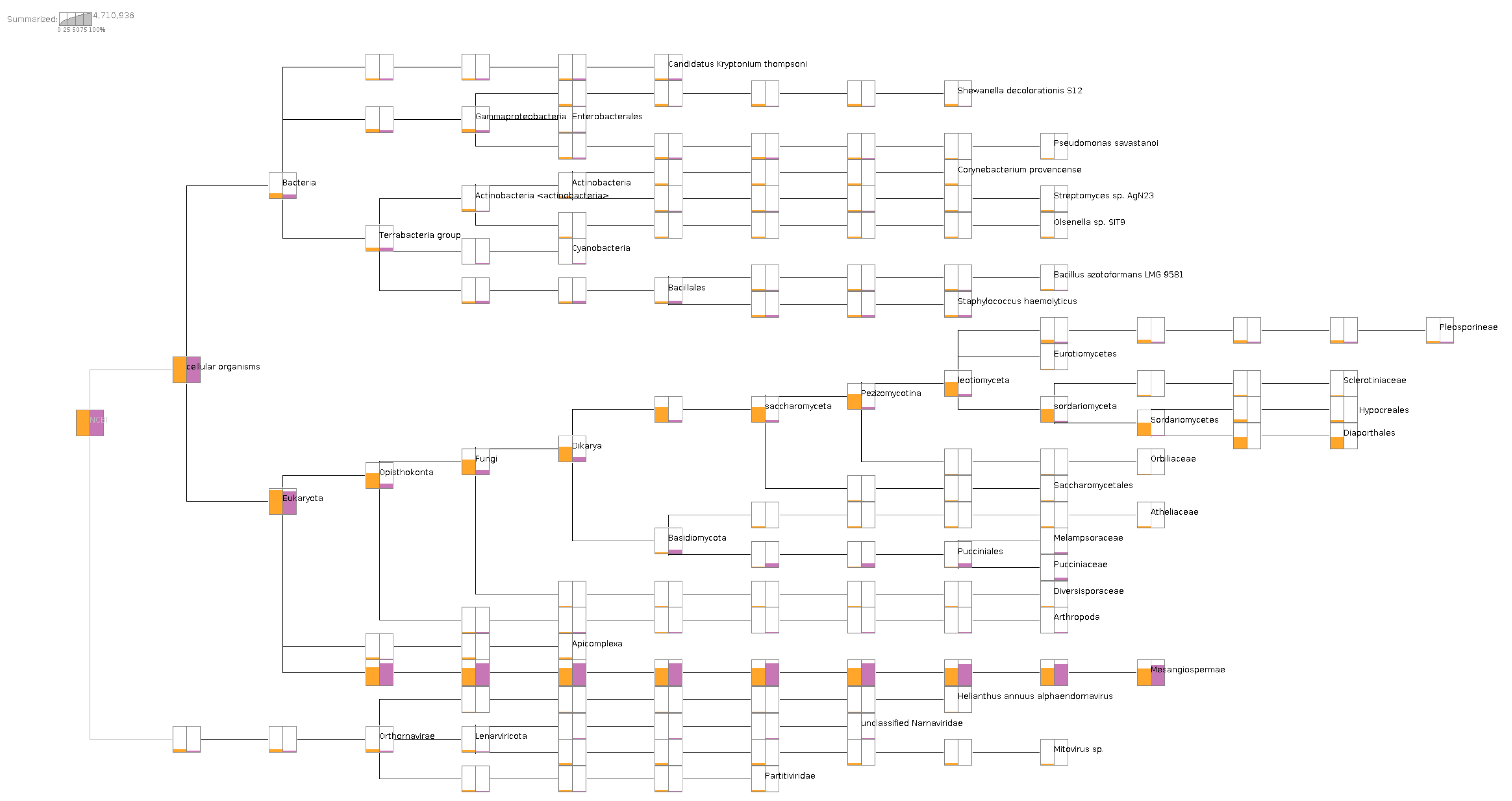
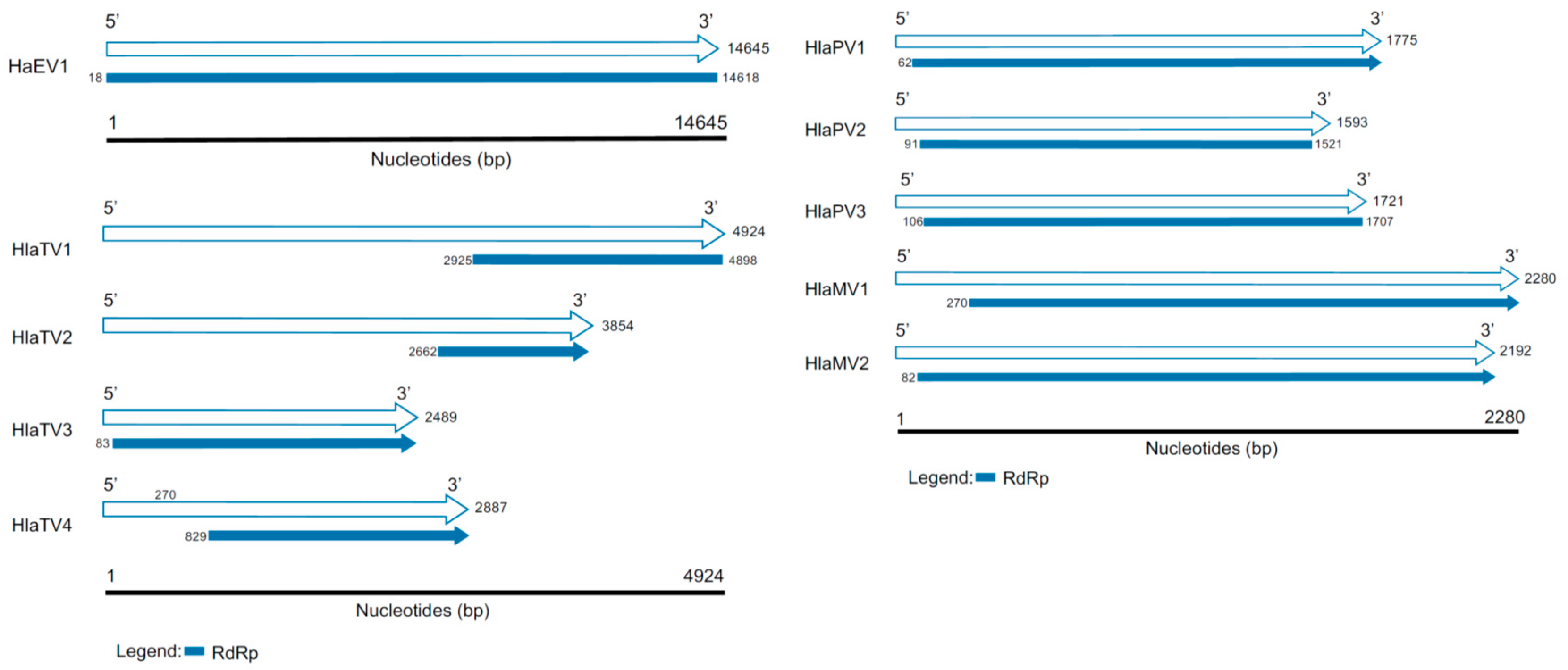

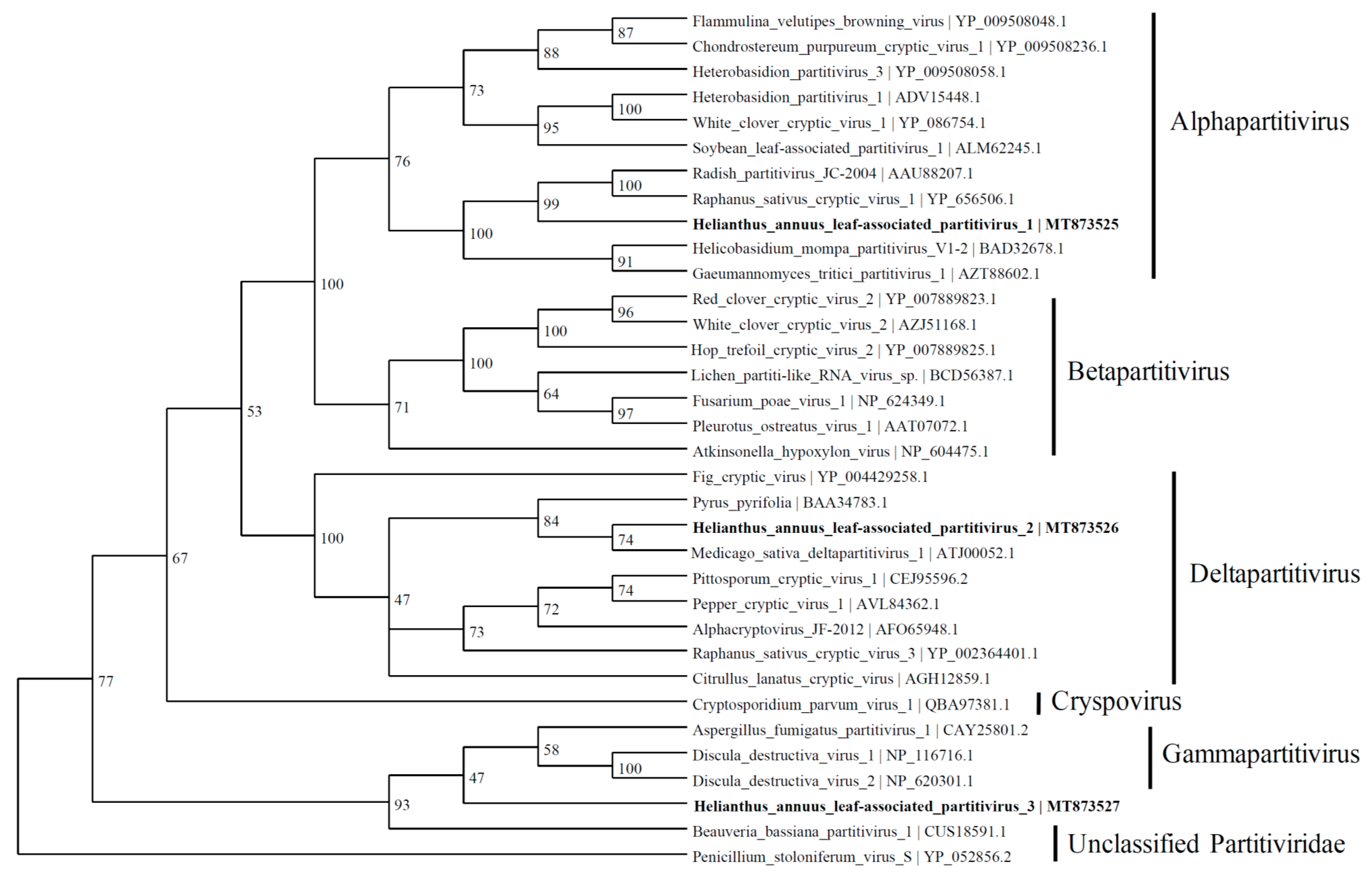
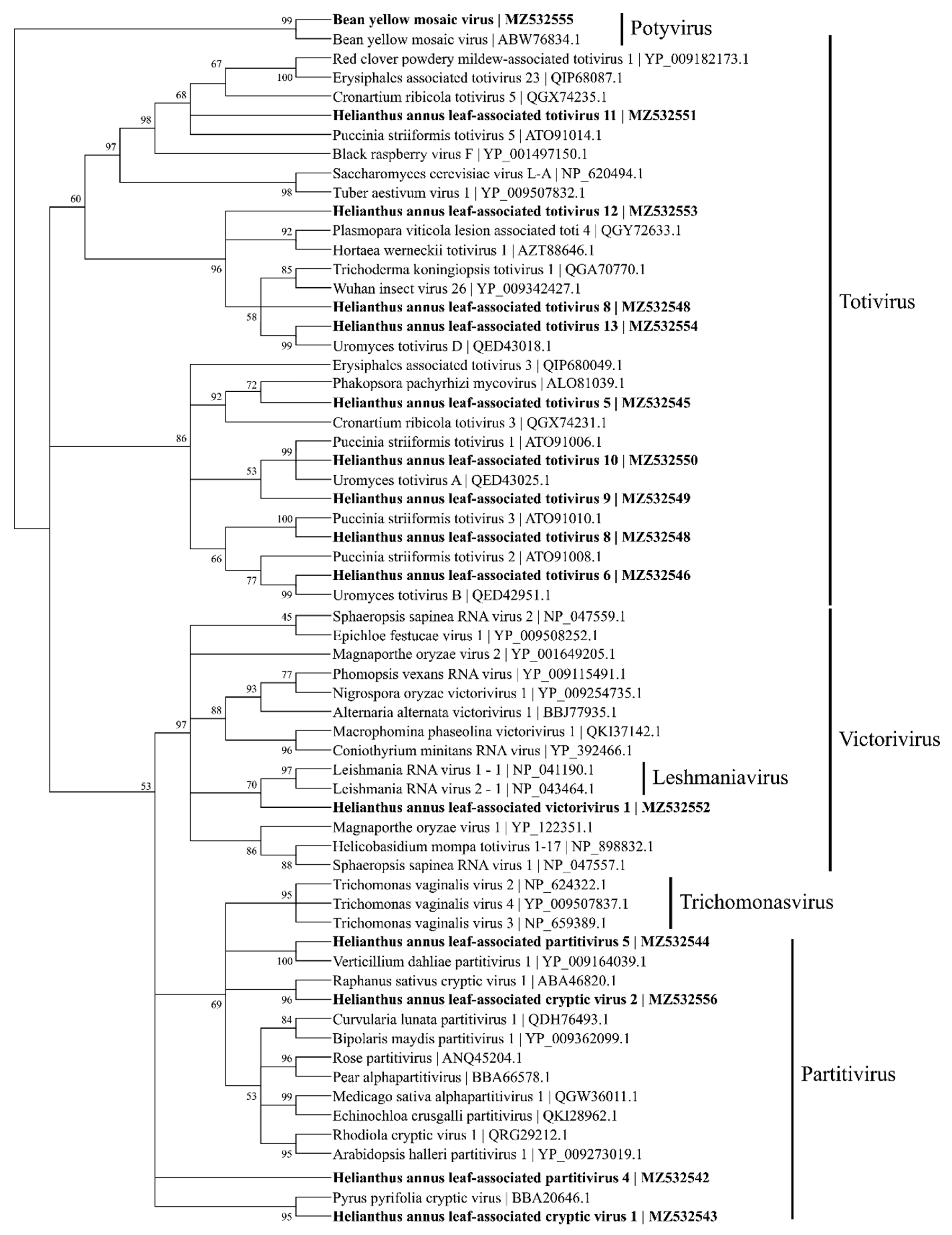
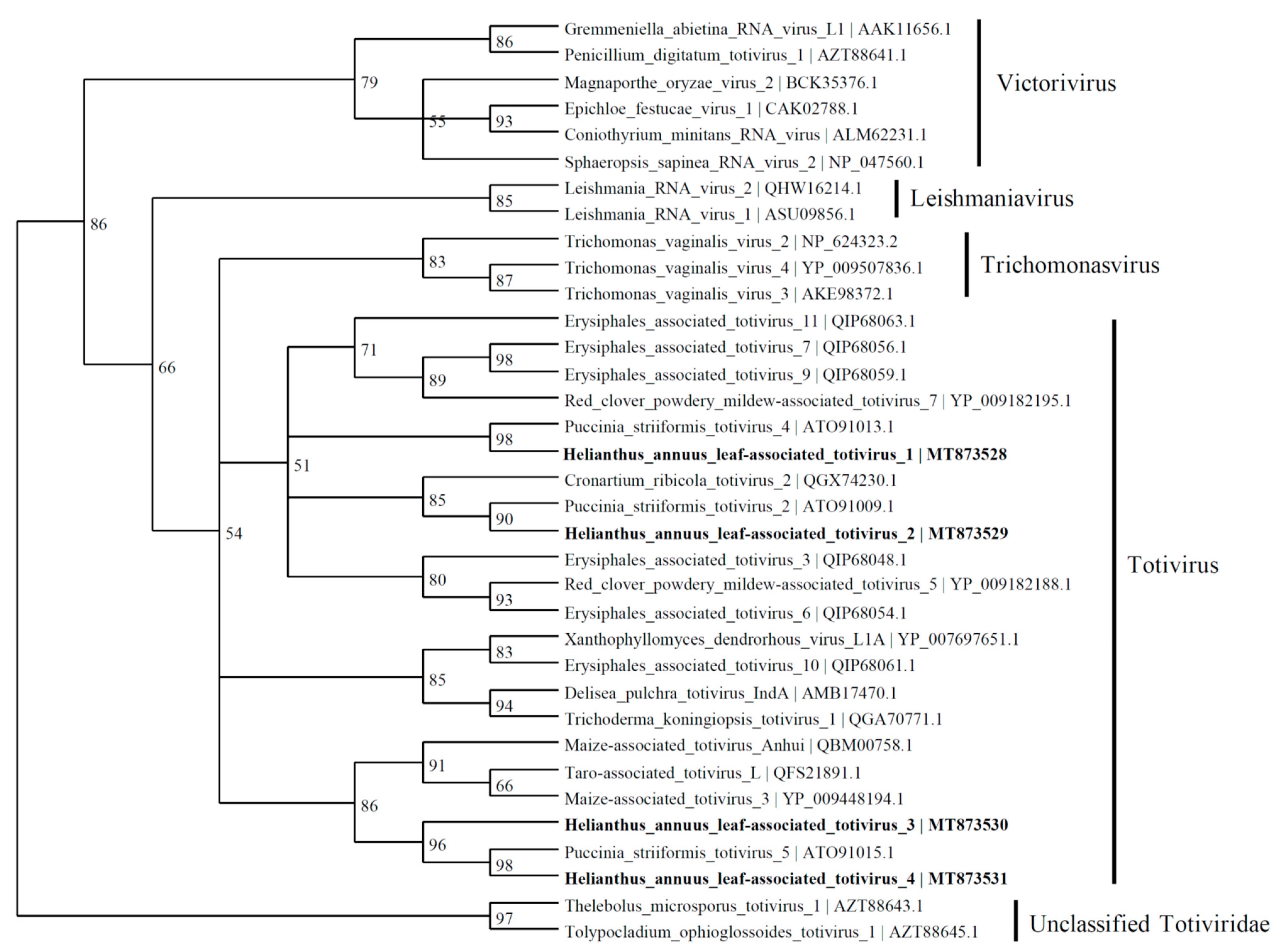
Publisher’s Note: MDPI stays neutral with regard to jurisdictional claims in published maps and institutional affiliations. |
© 2021 by the authors. Licensee MDPI, Basel, Switzerland. This article is an open access article distributed under the terms and conditions of the Creative Commons Attribution (CC BY) license (https://creativecommons.org/licenses/by/4.0/).
Share and Cite
Wang, Z.; Neupane, A.; Feng, J.; Pedersen, C.; Lee Marzano, S.-Y. Direct Metatranscriptomic Survey of the Sunflower Microbiome and Virome. Viruses 2021, 13, 1867. https://doi.org/10.3390/v13091867
Wang Z, Neupane A, Feng J, Pedersen C, Lee Marzano S-Y. Direct Metatranscriptomic Survey of the Sunflower Microbiome and Virome. Viruses. 2021; 13(9):1867. https://doi.org/10.3390/v13091867
Chicago/Turabian StyleWang, Ziyi, Achal Neupane, Jiuhuan Feng, Connor Pedersen, and Shin-Yi Lee Marzano. 2021. "Direct Metatranscriptomic Survey of the Sunflower Microbiome and Virome" Viruses 13, no. 9: 1867. https://doi.org/10.3390/v13091867
APA StyleWang, Z., Neupane, A., Feng, J., Pedersen, C., & Lee Marzano, S.-Y. (2021). Direct Metatranscriptomic Survey of the Sunflower Microbiome and Virome. Viruses, 13(9), 1867. https://doi.org/10.3390/v13091867





